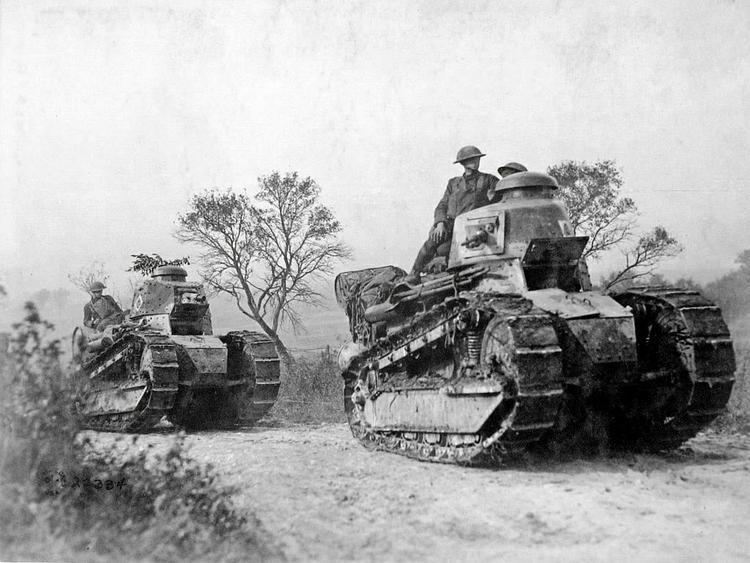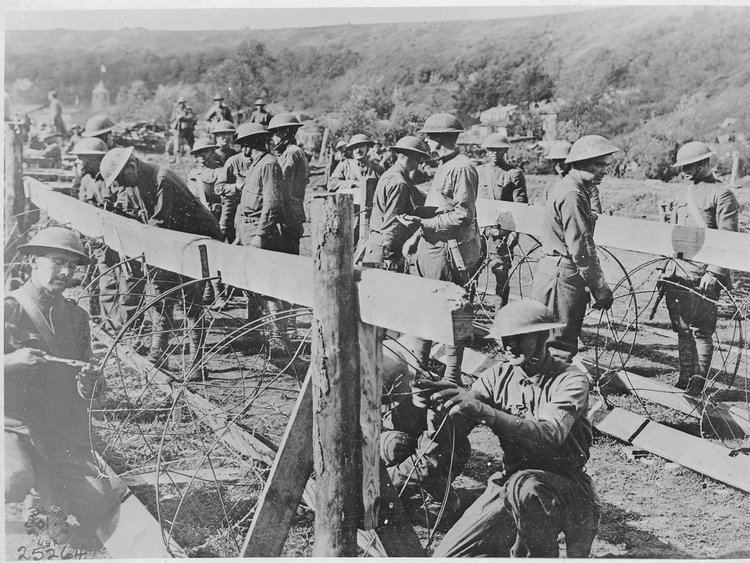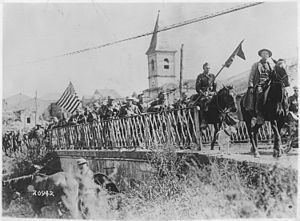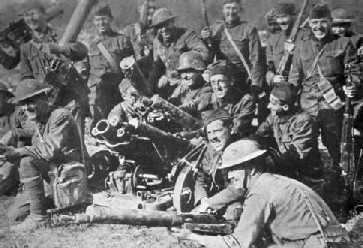Dates 12 Sep 1918 – 19 Sep 1918 | Result Allied victory | |
 | ||
7,000 (4,500 KIA, 2,500 WIA) 22,500 (2,000 KIA, 5,500 WIA, 15,000 POW)450 guns captured Similar World War I, Meuse‑Argonne Offensive, Battle of Château‑Thierry, Battle of Belleau Wood, Second Battle of the Marne | ||
Battle of saint mihiel
The Battle of Saint-Mihiel was a major World War I battle fought from 12–15 September 1918, involving the American Expeditionary Force (AEF) and 110,000 French troops under the command of General John J. Pershing of the United States against German positions. The U.S. Army Air Service (which later became the U.S. Air Force) played a significant role in this action.
Contents
- Battle of saint mihiel
- Saint mihiel heute today battle of saint mihiel 1918 frankreich france
- Background The Saint Mihiel salient
- Prelude
- Weather reports
- German defensive positions
- Allied tank support
- Battle
- Order of Battle First Army 12 September 1918
- Aftermath
- References

This battle marked the first use of the terms "D-Day" and "H-Hour" by the Americans. The fighting was depicted in the 1927 film Wings.

The attack at the St. Mihiel salient was part of a plan by Pershing in which he hoped that the Americans would break through the German lines and capture the fortified city of Metz. It was the first and only offensive launched solely by the United States Army in World War I, and the attack caught the Germans in the process of retreating. This meant that their artillery was out of place and the American attack, coming up against disorganized German forces, proved more successful than expected. The St. Mihiel attack established the stature of the U.S. Army in the eyes of the French and British forces, and again demonstrated the critical role of artillery during World War I and the difficulty of supplying such massive armies while they were on the move. The U.S. attack faltered as artillery and food supplies were left behind on the muddy roads. The attack on Metz was not realized, as the Germans refortified their positions and the Americans then turned their efforts to the Meuse-Argonne Offensive.

Saint mihiel heute today battle of saint mihiel 1918 frankreich france
Background: The Saint-Mihiel salient

Saint-Mihiel is a town in the Meuse department in northeastern France. Since the end of the 1870–71 Franco-Prussian War, the town was no longer considered important strategically and military installations were not developed. This changed early in World War I with the town inside the battlefront.
In 1914, the German command wished to take the Verdun fortifications which formed a strong point in the French lines. A first attempt, at Bois-le-Pretre (Priesterwald in German), failed despite violent fighting. During two more attempts (Battle of Flirey), German troops took Saint-Mihiel and the fort at Camp des Romains, but they were ultimately stopped at the Fort de Troyon to the south of Verdun.
During the course of the war the front did not change much in this area. Saint-Mihiel formed a salient inside the French lines, blocking communications between Nancy and Verdun. The area near St. Mihiel would know much fighting:
But despite French attacks the German forces were able to retain this strategic location until the last months of the war.
Prelude
General John Pershing thought that a successful Allied attack in the region of St. Mihiel, Metz, and Verdun would have a significant effect on the German Army. General Pershing was also aware that the area's terrain setting first dictated that the restricted rail and road communications into Verdun (restrictions that had been imposed by the German attack during the Battle of Flirey) be cleared, and that a continuation of the attack to capture the German railroad center at Metz would be devastating to the Germans. For this, he placed his confidence in a young First Infantry Division Major, George Marshall, to move troops and supplies effectively throughout the battle .After these goals were accomplished, the Americans could launch offensives into Germany proper. The American First Army had been activated in August and taken over the sector of the Allied line. Pershing had to persuade Marshall Foch (the supreme Allied military commander) to permit an American attack on the salient.
Weather reports
The weather corps of Corps I Operation Order stated: "Visibility: Heavy driving wind and rain during parts of day and night. Roads: Very muddy." This would pose a challenge to the Americans when the order to advance was given. In some parts of the road, the men were almost knee-deep in mud and water. After five days of rain, the ground was nearly impassable to both the American tanks and infantry. Many of the tanks were wrecked with water leakage into the engine, while others would get stuck in mud flows. Some of the infantrymen developed early stages of trench foot, even before the trenches were dug.
German defensive positions
Prior to the American operation, the Germans installed many in-depth series of trenches, wire obstacles, and machine-gun nests. The battlefields' terrain included the nearby premises of three villages: Vigneulles, Thiaucourt, and Hannonville-sous-les-Cotes. Their capture would accelerate the envelopment of the German divisions near St. Mihiel. The American forces planned to breach the trenches and then advance along the enemy's logistical road network.
The Germans knew many details about the Allied offensive campaign coming against them. One Swiss newspaper had published the date, time, and duration of the preparatory barrage. However, the German Army stationed in the area of St. Mihiel lacked sufficient manpower, firepower and effective leadership to launch a counter-attack of its own against the Allies. With Allied offensives to the north, the Germans decided to pull out of the St. Mihiel Salient and consolidate their forces near the Hindenburg Line. The order to evacuate the area was given on 8 September. The Allied forces discovered the information on a written order to Army Group Gallwitz.
Allied tank support
Although the AEF was new to the French theater of war, it trained hard for nearly a year in preparation for fighting against the German armies. The use by the British of tanks at the Battle of Cambrai in 1917 impressed General Pershing so much that he ordered the creation of a Tank force to support the AEF's infantry. As a result, by September 1918, Lieutenant Colonel George S. Patton Jr. had finished training two tank battalions – 144 French-built Renault FT light tanks organized as the 344th and 345th Battalions of the United States Tank Corps – at Langres, France for an upcoming offensive at the St. Mihiel salient. "Due to the serious resistance of the enemy, especially along the eastern edge of the FORET d’ARGONNE and in the vicinity of CHEPPY and VARENNES, and due also the lack of support of the Infantry, all the Tanks had contrary to plan entered the action before evening of the first day. The 344th Battalion supporting the advance of the 28th and 35th Divisions left the positions of departure and advanced ahead of the Infantry at H-hour (5:30 a.m.) On the morning of the 26th, Colonel G. S. Patton, Jr., commanding the Brigade of Tanks, was wounded while getting Tanks forward and rallying disorganized Infantrymen to attack enemy resistance. Major Sereno E. Brett, commanding the 344th Battalion, was then placed in command of the Brigade." Patton was awarded the Distinguished Service Cross for his "extraordinary heroism" that day. In addition to the 144 AEF tanks, the attack was joined by 275 French tanks (216 FTs and 59 Schneider CA1 and Saint-Chamond medium tanks) of the French 1st Assault Artillery Brigade; a total of 419 tanks.
Battle
The Saint-Mihiel offensive began on 12 September with a threefold assault on the salient. The main attack was made against the south face by two American corps. On the right was the I Corps (from right to left the 82nd, 90th, 5th, and 2nd Divisions in line with the 78th in reserve) covering a front from Pont-à-Mousson on the Moselle west toward Limey; on the left, the IV Corps (from right to left the 89th, 42d, and 1st Divisions in line with the 3rd in reserve) extending along a front from Limey west toward Marvoisin. A secondary thrust was carried out against the west face along the heights of the Meuse, from Mouilly north to Haudimont, by the V Corps (from right to left the 26th Division, the French 15th Colonial Division, and the 8th Brigade, 4th Division in line with the rest of the 4th in reserve). A holding attack against the apex, to keep the enemy in the salient, was made by the French II Colonial Corps (from right to left the French 39th Colonial Division, the French 26th Division, and the French 2d Cavalry Division in line). In First Army reserve were the American 35th, 80th, and 91st Divisions.
The Allies mobilized 1,481 aircraft to provide air superiority and close air support over the front. About 40% were American-flown in American units, the remainder were British, French, and Italian. Nine bomber squadrons of the British RAF, although provided for the battle, were not under Pershing's operational control.
Defending the salient was German "Army Detachment C", consisting of eight divisions and a brigade in the line and about two divisions in reserve. The Germans, now desperately short of manpower, had begun a step-by-step withdrawal from the salient only the day before the offensive began. The attack went so well on 12 September that Pershing ordered a speedup in the offensive. By the morning of 13 September, the 1st Division, advancing from the east, joined up with the 26th Division, moving in from the west, and before evening all objectives in the salient had been captured. At this point, Pershing halted further advances so that American units could be withdrawn for the coming Meuse-Argonne Offensive.
Order of Battle, First Army, 12 September 1918
Section source: OAFHFirst United States Army – Gen. John J Pershing
Aftermath
"General Pershing's operational planning of St. Mihiel separated the salient into several sectors. Each Corps had an assigned sector, by boundaries, that it could operate within. The American V Corps location was at the northwestern vertices, the II French Colonial Corps at the southern apex, and the American IV and I Corps at the southeastern vertices of the salient. Furthermore, General Pershing's intent was obvious; to envelope the salient by using the main enveloping thrusts of the attack against the weak vertices. The remaining forces would then advance on a broad front toward Metz. This pincer action, by the IV and V Corps, was to drive the attack into the salient and to link the friendly forces at the French village of Vigneulles, while the II French Colonial Corps kept the remaining Germans tied down."
"One reason for the American forces' success at St. Mihiel was General Pershing's thoroughly detailed operations order. Pershing's operation included detailed plans for penetrating the Germans' trenches, using a combined arms approach to warfare. His plan had tanks supporting the advancing infantry, with two tank companies interspersed into a depth of at least three lines, and a third tank company in reserve. The result of the detailed planning was an almost unopposed assault into the salient. The American I Corps reached its first day's objective before noon, and the second day's objective by late afternoon of the second".
"Another reason for the American success was the audacity of the small unit commanders on the battlefield. Unlike other officers who commanded their soldiers from the rear, Colonel Patton and his subordinates would lead their men from the front lines. They believed that a commander's personal control of the situation would help ease the chaos of the battlefield."
